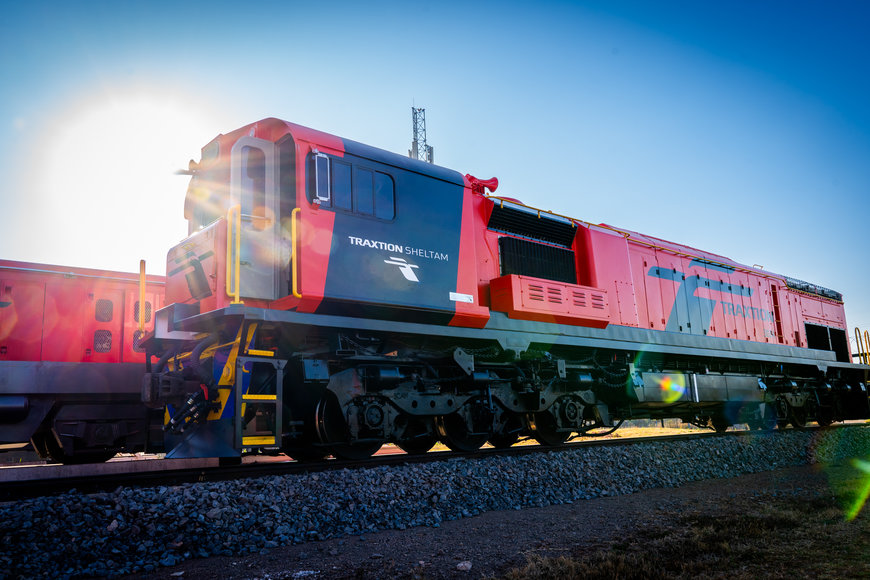Traxtion’s in-house expertise gives new life to locomotives on Africa’s rail network
Traxtion acquired five class 39 locomotives from Transnet in December 2022. This acquisition is part of their fleet expansion to meet the growing demand of freight rail services in Africa. The locomotives were immediately moved to Traxtion’s Rail Services Hub – their workshop in Rosslyn, Pretoria, for assessment and preparation for deployment.

Traxtion on the traverser.
The Rosslyn facility covers 50,000 square meters, of which 11,000 square meters is under roof. The findings resulted in the locomotives undergoing major overhauls, refurbishments, and modifications. Technical work on these powerful 2250kw (3000hp) locomotives is no small undertaking, but the full-service workshop was up to the task.
In rebuilding the class 39s for market, the locomotives underwent a 6-yearly major inspection, which included the evaluation and overhaul of all major and critical components. This ensured that any underlying faults were detected and addressed to reduce the chances of future breakdowns. This always guarantees Traxtion a healthy operational fleet.
In addition to that, this six-month project included the locomotives undergoing a weight reduction intervention to enable them to operate optimally on standard African tracks. Due to growing demand, the rail service hub technicians worked tirelessly to ensure that each locomotive was ready for the market. Some of the other work done on the class 39s included:
- Refurbishment of fuel injectors.
- Refurbishment of engine water and oil pumps.
- Replacement of turbo chargers.
- Refurbishing the entire brake system.
- Load testing.
- Reprofiling of wheels and the refurbishment of AP bearings.
Technicians also accessed and stripped other major components to bring them back to full operational standards. The body and tank weight were reduced so that the locomotives could transport more tonnes per load without breaching the regional axle load limits or damaging the infrastructure.
As the demand for locomotives is increasing, the Traxtion technical fleet will grow accordingly. The company is preparing for the next phase of adding new locomotives to the fleet. Traxtion now has a fleet of 60 locomotives and is operating in 8 African Countries.
The class 39-000 series of locomotives – a brief history
During 2005 Transnet began a process of upgrading the ageing class 34 diesel locomotive fleet. It was decided to base the modifications on the General Motors EMD series as they could be more readily converted, as opposed to the General Electric equivalent. The re-design was far reaching and included:
- Upgraded turbocharged and after-cooled 2-stroke V16 engine with the output increased by 15%
- Microprocessor controls
- Improved alternator and rectification
- New brakes replacing the pneumatic control system
- Improved cab with better visibility, and facilities such as a toilet and air conditioning
- Ungraded D31 traction motors
- Strengthened frame equivalent to the class 37
- Tractive effort of 245kN at 20% adhesion at 26kmh
- Continuous power rating of 2250kW
- Mass increased to 119t (19.83t per axle)
The prototype 39-001 was tested extensively over a two-year period. Traxtion acquired locomotives 39-001 to 39-005, whose previous identities with Transnet were: 39-001 (34-635), 39-002 (34-838), 39-003 (34-674), 39-004 (34-620), 39-005 (34-829).
These locomotives were locally manufactured by General Motors and were placed in service between 1974 and 1976 (34-600 series) and 1978-1979 (34-800 series first order).
The Class 39-200 series
The class 39-000 proved to be an effective but expensive conversion. The series that followed were to be built to similar specification, but tests with the prototype 39-251(rebuilt from 37-010) during 2008 were not entirely satisfactory. As a result, the class 39-200 were built “as new” by TRE with imported major components, including the chassis, although the engines are refurbished rather than new. Some body panels were manufactured locally. The order for 50 locomotives was completed by 2010 and they were numbered 39-201 to 39-250.
www.traxtion.com

